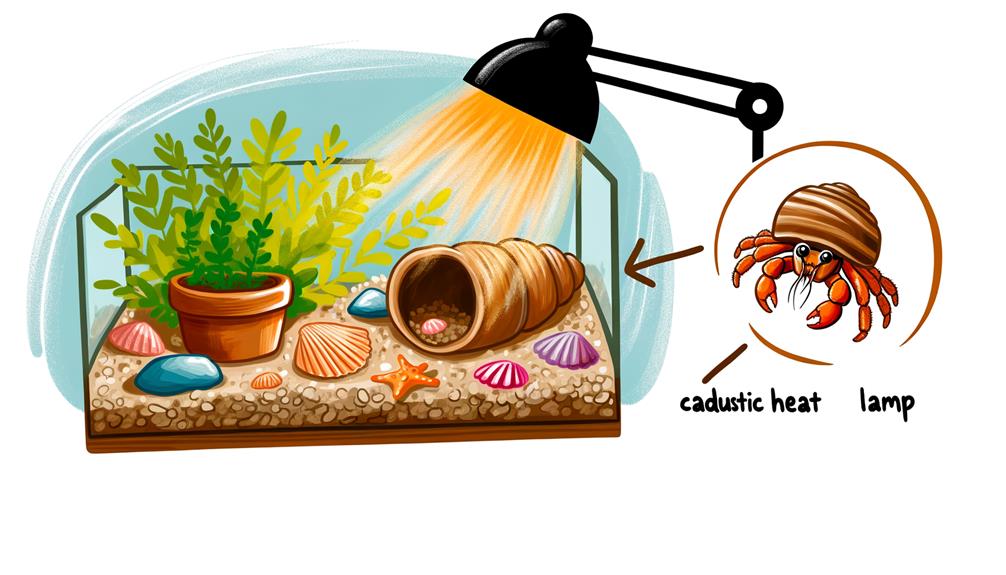Do Hermit Crabs Need Air?
Yes, hermit crabs require a heat lamp to maintain their ideal tropical environment. These crustaceans need steady warmth to support their metabolic processes, digestion, and respiratory health.
Without sufficient heat, they might become lethargic, stressed, or develop severe complications like improper molting. A heat lamp helps replicate their natural coastal habitat by creating a thermal gradient, which is vital for their overall well-being.
Regular temperature monitoring guarantees your heat settings are just right, preventing dehydration or overheating. To improve your hermit crabs' health and environment, understanding the advantages of proper heating is necessary.

Key Takeaways
- Hermit crabs need consistent warmth to mimic tropical environments.
- Heat lamps create a thermal gradient essential for hermit crab health.
- Proper heating prevents lethargy, stress, and molting issues.
- Heat lamps support respiratory health and improve digestion.
- Reliable temperature monitoring with heat lamps reduces disease susceptibility.
Understanding Hermit Crab Habitats
When setting up a habitat for your hermit crab, it's important to replicate the warm, humid conditions of their natural coastal environments to guarantee their health and wellbeing.
You should start by selecting an appropriately sized terrarium with a secure lid to maintain humidity levels. Use a substrate like coconut fiber or sand, kept damp but not waterlogged, to mimic their natural terrain.
Include both fresh and saltwater dishes, as hermit crabs require both for hydration and molting. Adding climbing structures and hiding spots, such as rocks, driftwood, and shells, will provide stimulation and shelter.
Importance of Temperature Control
Maintaining the appropriate temperature in your hermit crab's habitat is essential to their health, as these creatures thrive in warm environments similar to their native coastal regions. Ideally, you should keep the temperature between 75°F and 85°F.
When temperatures drop below this range, hermit crabs can become lethargic, stressed, and susceptible to illnesses. Conversely, excessively high temperatures can lead to dehydration and heat stress.
Use a dependable thermometer to monitor the habitat's temperature regularly. Consistent temperature control supports their metabolic processes, aids in molting, and promotes overall well-being.
Benefits of Using Heat Lamps
Utilizing heat lamps can provide a consistent and controllable source of warmth, essential for your hermit crabs' habitat to remain within the ideal temperature range. By maintaining temperatures between 75-85°F, you can help regulate their metabolism, molting cycles, and daily activities.
Heat lamps allow you to create a thermal gradient, giving your hermit crabs the option to move between warmer and cooler areas as needed. This mimics their natural environment and supports their physiological well-being.
Additionally, heat lamps can help prevent respiratory issues and promote proper digestion. Investing in a quality heat lamp with adjustable settings ensures you can fine-tune the environment, catering to your hermit crabs' specific needs and enhancing their overall health and well-being.
Risks of Inadequate Heating
Failing to provide adequate heating for your hermit crabs can lead to a range of health issues, including slowed metabolism, improper molting, and increased susceptibility to disease. When hermit crabs are kept in environments that are too cold, their physiological functions begin to deteriorate. They might become lethargic, and their immune systems can weaken, making them more prone to infections.
To prevent these problems, make sure your hermit crabs have a consistent and appropriate heat source. Here's what you risk without proper heating:
- Slowed Metabolism – Reduced energy and activity levels.
- Improper Molting – Risking life-threatening complications.
- Increased Disease Susceptibility – Higher infection rates.
- Behavioral Changes – Increased stress and aggression.
Providing the right heat is essential for their well-being.
Ideal Temperature Ranges
To guarantee your hermit crabs thrive, maintaining their habitat within an ideal temperature range of 75-85°F is necessary. This range mimics their natural tropical environments, promoting peak health and activity.
At temperatures below 75°F, hermit crabs become lethargic, risking metabolic slowdown and increased vulnerability to illness. Conversely, temperatures above 85°F can cause overheating and dehydration, leading to stress and potential mortality.
Monitoring the temperature with a reliable thermometer ensures consistency. Maintaining this range supports essential biological processes, such as molting and shell selection, necessary for their well-being.
Hence, regularly checking and adjusting the habitat's temperature is crucial, ensuring a stable, comfortable environment for your hermit crabs to flourish.
Alternative Heating Methods
Many effective alternative heating methods exist to maintain your hermit crabs' habitat within the best temperature range. By considering these options, you can guarantee a safe and comfortable environment for your pets.
- Under-tank heaters (UTH): These adhere to the bottom or side of the tank, providing consistent warmth without overheating.
- Ceramic heat emitters: These produce heat without emitting light, making them ideal for nighttime use.
- Heat mats: Placed underneath the tank or on the sides, heat mats distribute warmth evenly.
- Heat cables: Flexible and versatile, they can be wrapped around the tank to target specific areas.
Each method has distinct advantages, ensuring your hermit crabs thrive while you fulfill their needs effectively.
Monitoring and Adjusting Temperature
Regularly monitoring the temperature in your hermit crab's habitat is essential for maintaining their health and well-being. Use a reliable digital thermometer to track the ambient temperature, ensuring it stays within the ideal range of 75-85°F (24-29°C).
Place the thermometer at crab level for accurate readings. Adjust the heat source accordingly, whether it's a heat lamp, under-tank heater, or ceramic heat emitter. If temperatures fluctuate, consider using a thermostat to maintain consistency automatically.
Check the habitat daily, and make small adjustments to avoid sudden changes that could stress your hermit crabs. Remember, a stable environment not only promotes longevity but also enhances their natural behaviors, ultimately contributing to their overall happiness and well-being.
Conclusion
Finally, ensuring the right temperature for your hermit crab is essential, much like maintaining a delicate balance in a finely-tuned instrument.
Heat lamps offer a reliable way to maintain this balance, preventing the risks associated with inadequate heating.
While alternative methods exist, they require careful monitoring and adjustment.
By understanding and controlling temperature, you're fostering a healthy, thriving environment for your hermit crab, just as nature intended.






